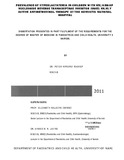| dc.description.abstract | Background: Children with HIV/AIDS live longer and healthier lives because of treatment advances such as highly active antiretroviral therapy (HAART) and treatment of opportunistic infections. In Kenya the national guidelines recommend the use of regimens based on a backbone of two nucleoside reverse transcriptase inhibitors (NRTI).
Elevated lactate levels and life threatening hepatic dysfunction have been described in children and adults on HMRT regimen containing NRTls but few studies are available that evaluate lactate levels among African children. The final common pathway for most of these toxicities is thought to be through mitochondrial damage leading to impairment of the aerobic
respiration leading to accumulation of lactic acid the dead end product of anaerobic respiration resulting in hyperlactatemia, life threatening lactic acidosis and hepatic steatosis
in these individuals.
Objectives:
The primary objective was to determine the prevalence of hyperlactatemia among children on treatment with NRTI based HAART reqirnen attending the comprehensive care centre clinic at Kenyatta National Hospital. The secondary objective was to describe the factors associated with hyperlactatemia.
Study design:
This was a hospital based descriptive cross sectional study during the year 2010.
Methods:
Blood samples were drawn from these patients and analyzed for L-Iactate. Treatment history and baseline data were corroborated from the patients' records. The primary objective was achieved by calculating the overall and age-specific prevalence. The secondary objective was achieved by analysis of the correlates for hyperlactatemia by description and comparison of the characteristics of patients with and without hyperlactaterna, with the aid of software programs (Epi-Info and SPSS). P-value of less than 0.05 was considered significant. Results were presented in tables, charts (pie), and graphs as appropriate.
Results:
A total of 271 children were recruited into the study. The overall prevalence of hyperlactatemia was found to be 11.8%. There were significant differences in the age
specific prevalence. The highest prevalence was in the children of the 6-<10 years age group at 17.9% (OR 5.8; 95% C11.7 - 20.9), children aged 2-<6 years had a prevalence of
13.2% (OR 4.2; 95% CI 1.2 - 15.7) compared to children ~10 years who had a prevalence of 3.6%.89.9% of the children with hyperlactatemia had mildly elevated levels. No significant correlation was found between hyperlactaternia with other factors explored.
Conclusion:
The prevalence of hyperlactatemia among children on NRTI-based HAART at Kenyatta National Hospital Comprehensive Care Centre is comparable to that found in other similar studies but children under ten years had the greatest prevalence and a 4.2 - 5.8 fold increased risk for hyperlactatemia. Most of the children with hyperlactatemia had a mild elevation of the lactic acid levels.
Recommendation: There is need to evaluate lactic acid levels at baseline for children on HAART and at three months follow-up visits for those children with increased levels to determine the trend especially those below ten years of age. | en_US |

